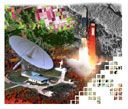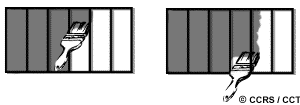
| Table of Contents |
| 1. Introduction 2. Sensors 3. Microwaves 4. Image Analysis 5. Applications |
Fundamentals of Remote Sensing
2.4 Whiz Quiz - Answers
Answer 1: Hyperspectral scanners have very high spectral resolution because of their narrow bandwidths. By measuring radiation over several small wavelength ranges, we are able to effectively build up a continuous spectrum of the radiation detected for each pixel in an image. This allows for fine differentiation between targets based on detailed reflectance and absorption responses which are not detectable using the broad wavelength ranges of conventional multispectral scanners. However, with this increased sensitivity comes significant increases in the volume of data collected. This makes both storage and manipulation of the data, even in a computer environment, much more difficult. Analyzing multiple images at one time or combining them, becomes cumbersome, and trying to identify and explain what each unique response represents in the "real world" is often difficult.
Back to the question...

Answer 2: The total wavelength range available will be 0.90-0.40 mm = 0.50 mm. If there are 288 channels of 1.8 nm each, let's calculate the total wavelength range they would span if they did not overlap.
1.8 nm = 1.8 x 10-9 m
1.8 x10-9 m X 288 = 0.0000005184 m
0.0000005184 m = 0.5184 mm
Since 0.5184 is greater than 0.50, the answer is YES, there will be have to be some overlap between some or all of the 288 bands to fit into this 0.50 mm range. Back to the question...
| Updated2002-08-21 | Important Notices |